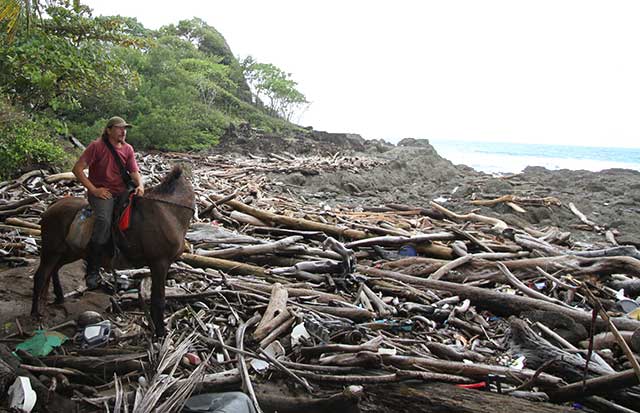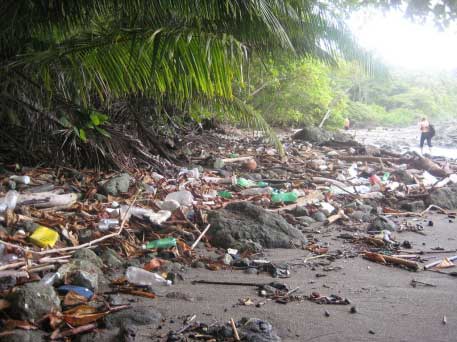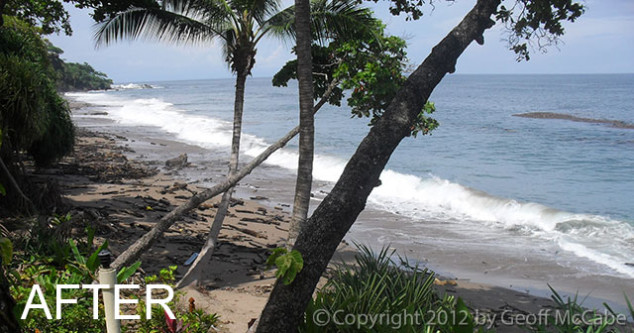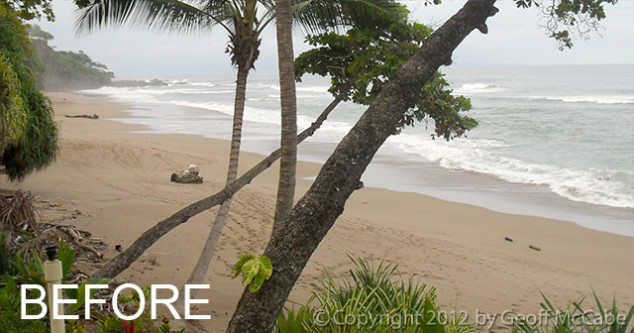- Home
- Accommodation
- Activities
- Area Info
- Maps
- Photo Galleries
- Real Estate
- Travel
Beach Cleanup – Where Does All That Trash Come From?
Added by Geoff McCabe on October 27, 2012
Saved under Blog, Conservation, News
Tags: slider
Saved under Blog, Conservation, News
Tags: slider
Just about everyone, no matter what country you live in, has had the shock of arriving at what you imagine will be a pristine beach, only to discover that it’s covered with all types of trash. Plastic bottles, flip flops, plastic toys, etc. Any junk that floats will be found washed up on the area’s beaches.
It’s a very sad phenomenon here, and there’s no escape from it. In fact, the more remote the beach, the dirtier it will be. That’s because a beach that’s far from people is more difficult to clean up.
Where does beach trash really come from?
Where does it all come from? Who is leaving it all there? Some of the trash is just dropped there by beach-goers. I’ve seen a family arrive at the beach, open dozens of plastic-wrapped goodies and then abandon it all when they leave. Disgusting! It’s a shock that anyone in this day and age could be so unaware. But, that’s not where most of the trash comes from.
A bit of the trash comes, piece by piece from the sea. Fishermen may throw something overboard here or there, and this stuff washes up, but that’s not where most of it comes from. It doesn’t generally come from China or other countries. Many people imagine that there could be barges full of trash being dumped into the ocean, but that’s not it either.
The fact of it is that most of it comes from Costa Rica itself… from San Jose and other local cities that have rivers within their urban areas. Much of it probably comes from the Rio Tarcoles, which is across the Gulf of Nicoya from our beaches. This denial of responsibility and hopelessness that there’s anything that the country can do about it besides clean it up afterwards is part of the problem.
 Why does most beach trash come during rainy season?
Why does most beach trash come during rainy season?
Most of it comes in big slicks… giant floating trash dumps that can extend for miles. What happens is that within urban areas, some many poor people, who can’t afford trash collection fees, live in shantytowns on the edge of rivers. They throw their trash on the riverbanks, where it piles up waiting for a flood. When a heavy rain comes, the water levels rise and take huge amounts of trash with it, and when it his the ocean, it forms huge plumes of colorful debris, mixed also with tons of wood, trees, and anything else that floats and might be sitting on a riverbank. Some of dubbed this form of trash “Flash Flood Flotsam.” These plumes spread out into a long ribbon of trash over time, and eventually will wash up on a beach somewhere, often covering beaches with trash for miles, all within a few minutes.
I saw this happen once at the beach when I was staying at a house at Tango Mar near Tambor. The beach was beautifully clean, and then I saw a disturbance on the horizon, which extended as far as my eyes could see in both directions. Within an hour or so, this floating waste dump approached the beach and nearly completely covered the entire beach with trash, wood, a tree with leaves still on it, and even a shocked but still-living Iguana. The BEFORE and AFTER photos at the top of this article show the same beach with two photos taken less than a day apart. In the photos you can see mostly wood logs, but trust me, mixed in with the wood is tons of plastic garbage.
I was alone at the time so decided to clean the beach myself. Over a couple of hours, I filled about 4-5 large black garbage bags with plastic trash, just from a 50 meter or so part of the beach. One can imagine the huge quantities of trash that were deposited on the entire coast from Tambor down to Montezuma and Cabuya, and many kilometers of that is remote beach with no access other than hiking in on foot, with no one to clean it up.
So the trash sits on the beach, with the sun gradually weakening it (meanwhile leaching out cancer-causing and endocrine-disrupting chemicals into the environment). The waves, rocks, and sand break this plastic into tiny grains of low-toxicity waste that get into everything. For more info on the toxins in plastic bottles, read this article: Livestrong: Which plastic bottles are unsafe to drink from? You can see the breakdown of plastic into tiny bits of colored sand as you walk to Playa Grande, in areas between in the big beaches where no one cleans it up, such as the waters in front of Nicolas Wessberg Wildlife Reserve.
Ecoutourism and Beach Trash

Costa Rica is supposed to be a paradigm of eco-tourism, and some tourists are shocked when they see the beaches here, especially towards the end of rainy season in October and November before beach cleanups have helped the problem. Some have even written extensive testimony, such as Gigi Yogini’s blog here: The Shoe Project – Proyecto Zapato, devoted to the questions of “Where do all these shoes come from that are found on the beaches in Costa Rica?” While the majority of tourists see beautiful clean beaches in Costa Rica since they visit after the cleanups, they stay on beaches that are closer to populated areas, and in dry season are no flash floods to create these slicks of flash flood flotsam, there’s certainly an impact on the perception of Costa Rica’s claim to be a country that cares about the environment.
Says the author:
If this is the paradigm of ecotourism, then I am brutally disappointed. Where is the disconnect, I wonder? If tourism is “the country’s top source of employment and investment,” and if Costa Rica is considered the “paradigm of ecotourism,” then either A. The country needs to invest in its waste management or B. We need to redefine ecotourism. – Gigi Yogini
So what’s the solution?
Organized Local Beach Cleanups – Beach cleanups are necessary, and are organized in Montezuma and Santa Teresa, generally by the hotels that have guests coming who expect a clean beach. These hotel-organized efforts generally clean the beach in front of their place of business and ignore the more remote areas. Efforts have been made to do general beach cleanups, but organizers have found that generally it’s difficult to get the large numbers of people they really need to make a real difference in the more distant areas. Plus, there are some areas where there are literally millions of small pieces of plastic trash that are nearly impossible to physically pick up.
Government Funded Cleanups – What’s needed is government funding to do regular beach cleanups, both by the national park system, and in general as part of the normal trash collection process. A fairly easy solution would be to charge a deposit on all plastic bottles, with the proceeds going toward beach cleanups. This would lead to more recycling and re-use of plastic bottles as well.
Riverbank Trash Prevention – The most important thing that must be done is that the government must tackle the problem at its roots, but finding the areas where trash is being thrown into the rivers, and keeping that trash out of the rivers in the first place. That would be the cheapest and easiest solution.
Public Awareness – The easiest way to make the public aware of the problem is to just get them to the beach in rainy season to see it for themselves. Everyone can see there’s a problem, what we need is public awareness about SOLUTIONS and CIVIC RESPONSIBILITY. The people of Costa Rica need to demand more of their leaders, and support creative solutions. A great example is local artist Nefertiti’s “Chunches de Mar” festival that brings artists from around Costa Rica to the Montezuma area for beach cleanups and to build art out of the trash they find, which are then put on display in a national museum in San Jose.
Categories
Great Stuff

Clandestina Restaurant
My new favorite restaurant, Clandestina is not to be missed by food lovers staying anywhere near to Montezuma. Established in March 2015, Clandestina is the new kid on the block. The Oregon/Tico collaboration is a winner among locals and travelers alike, with artisan craft beers, made onsite by Butterfly Brewing Co. and delicious, exciting […]
Added By Geoff McCabe on May 20, 2015
Montezuma Social
© 2012, ↑ Montezuma Costa Rica















